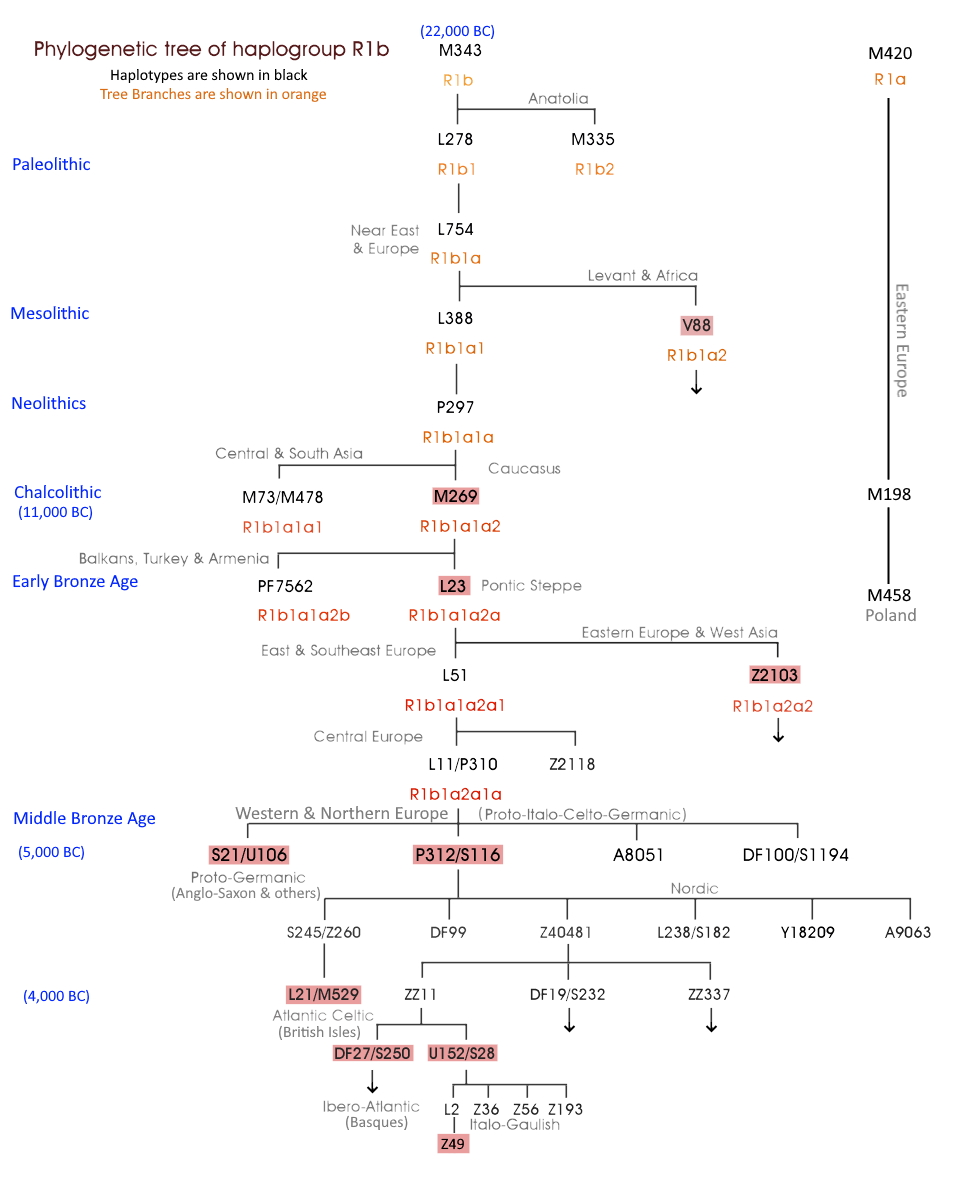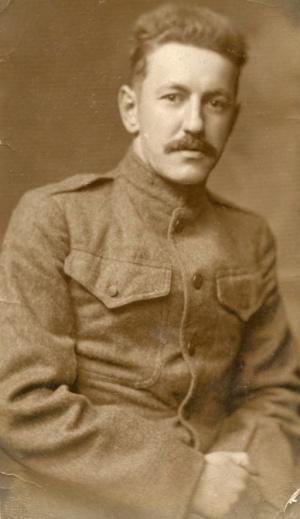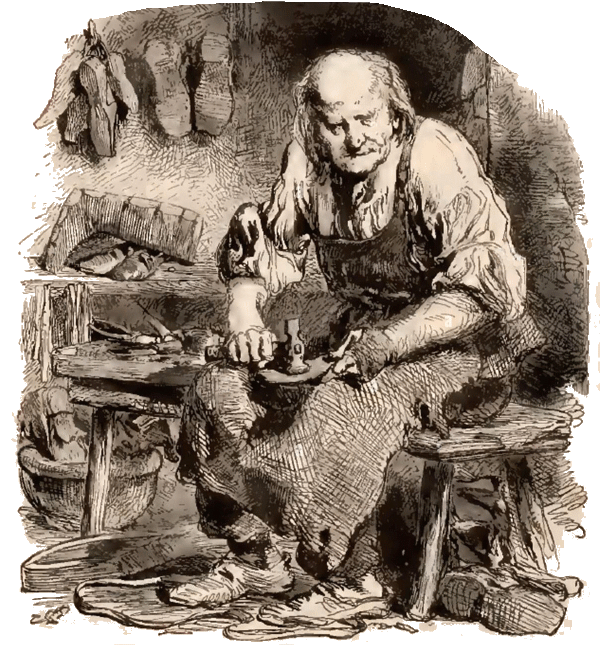|
DNA Evidence, Family Stories, and other Clues on the
DNA Evidence for James F. Clark Family Origins
DNA analyses of members of our family provide some interesting clues about the origins of our paternal grandfather James F. Clark, Sr.. First, we are told that he had a Scottish father, and possibly an Irish mother. Also, we have been led to believe that he is the second in a line of three James F. Clarks originating in the Scottish Highlands. However, our Y-DNA puts us, and therefore him, in the R-Z49 haplogroup, which is a derivative of the R-U152 (U152 > L2 > Z49) mutation that originates not in Scotland nor Ireland, but in the Alpine region of Europe. This means that even though the first James F. Clark (i.e., our grandfather's father) may have been born in the Scottish Highlands, his paternal ancestry in ancient times is not Gaelic/Celtic (i.e., pure Scot), but possibly Norman (French), Gallic (French), or maybe even southern Germany. This does not rule out the possibility that the first James F. Clark could have had a Gaelic/Celtic mother or grandmother, but it does demonstrate that his parternal ancestry has to ultimately be of central European (i.e., Alpine) origin, which includes the Normans and Gauls of France, among others, but not Gaelic/Celtic, nor for that matter Anglo-Saxon. Second, autosomal DNA analyses (i.e, of the 22 non-sex chromosomes) strongly indicate that our grandfather is almost certainly a grandson of Johann Lewandowski (1814-1889) and Anna Kuglin (1818-1899), who came from the Gdansk (Danzig) region of modern Poland, which from 1793 up until the end of WWII was part of the German province of West Prussia. Although we do not know at this point if Johann and Anna are maternal or paternal grandparents of our grandfather James F. Clark, we do know that Johann and Anna had seven or eight children, who emigrated in the 1880s or earlier to Detroit, Michigan. We also know that we share DNA with many "genetic cousins" from Detroit, who have Lewandowski ancestry. Thus, our line must descend from a child of Johann and Anna. As such, this requires that either our Scottish great-grandfather needs to be replaced by a Polish ancestor, or our Irish great-grandmother needs to be replaced by a Polish ancestor. 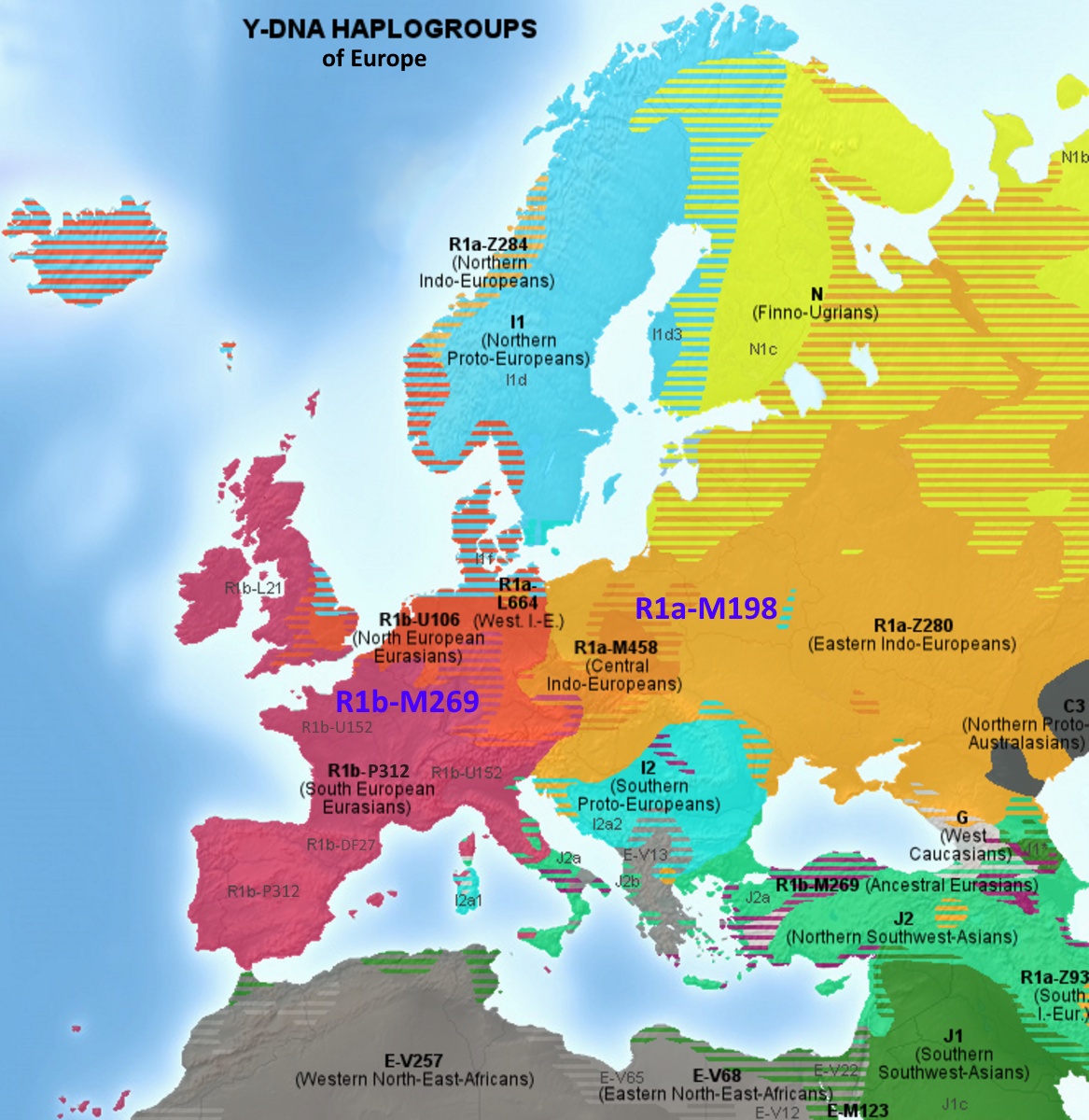
Interestingly, the aforementioned Y-DNA data may shed light on the Irish vesus Polish ancestry of our great-grandmother. As it turns out, a Y-DNA analysis has been done on one of the direct male descendants of the paternal line of Johann Lewandowski, and he tests postitive for the U152 mutation, but negative for the Z49 mutation, whereas the direct male descendants of the paternal line of James F. Clark, Sr test positive for both mutations. Thus, the biologic father of James F. Clark senior cannot possibly be a male descendant of Johann Lewandowski, and by the process of elimination, his biologic mother must be a descendant, and almost certainly a daughter, of the Lewandowski line. Autosomal DNA ethnicity estimates from LivingDNA.com and Ancestry.com, which admittedly are only as good as the statistical populations that they are based on, show very little, if any, Irish ancestry in the descendants of James F. Clark, Sr. This would seem to confirm that his biologic mother is German/Polish, not Irish. If such is the case, then we can assume that the Irish great-grandmother of the family stories is actually a stepmother, and that the biologic mother of James has to be a woman of German/Polish ancestry. The ethnicity estimates do show that that descendants of James Sr. have Scottish ancestry, though admittedly this does not need to be from his DNA contribution, as his daughter-in-law Jacqueline Bunce could possibly have some Scottish ancestry in her DNA that we are not aware of. Although the DNA evidence shows that the Clark and Lewandowski paternal lines are not related in recent times, everyone of western European descent is more or less related if we go far enough back in time. Because both the Clark and Lewandowski paternal lines contain the U152 mutation, they have to share a common ancestor sometime in the distant past. Since only the Clark paternal line has the Z49 mutation, a derivative of U152, the two lines diverged prior to the middle Bronze Age, when the Z49 mutation is thought to have evolved. This means that the common ancestor in the paternal lines of the male members of the Clark and Lewandowski families lived in western Europe some 4,000 to 3,500 years ago, give or take two or three hundred years - in other words, many, many generations before Johann Lewandowski and his sons appeared on this earth.
Our Family Stories - These were related to us by our father, James F. Clark, Jr., who was the only child of James F. Clark, Sr. -- both of them being known to friends and family as Jim Clark. We believe that these stories have an element of truth to them, but we fully recognize that family stories can evolve and change quite a bit as they are retold over the years, and the way we interpret them may be quite different from how they were originally told. The Names of his Step-parents - Our family stories relate that Jim Clark, Sr. was born in 1889 in Detroit, and orphaned at about age of 5 or 6 years, whereupon he was sent to live with a German-Jew family somewhere in the city.
The Name of his Older Step-brother - Our family stories relate that Jim Clark, Sr. had an older step-brother from out west, who came home one night in a drunken rage, and kicked Jim down the stairs, breaking his collar bone. The stories also tell the seemingly unrelated fact that Jim's stepfather sent Jim at the age of about 10 to work as a brakeman in the railroad yards. Perhaps the "older bother" of Jim was actually his biologic uncle and likely stepfather William Lewandowski, who is on record as being a violent man with a drinking problem, as William's wife Anna tried to divorce him in 1904 for these stated reasons. Anna had a brother, Gus Holden, who lived in Wyoming, and at times South Dakota, where he was as an engineer for the railroad. This means that Gus not only lived "out West", but he probably had contacts to get Jim a job as a railroad brakeman. The fact that Gus lived out West is significant, as everyone else in the Lewandowski circle of relatives lived in Detroit. Another important point is that Gus and Anna's mother is shown in several of the Detroit City Directories as living at the same address as Anna and her husband William. Thus, it very likely that Gus Holden was a visitor to the Lewandowski household whenever his railroad job brought him into town.
The Name of his Older Sister - Our family stories relate that when Jim joined the Army and was sent overseas during WWI, he used to write to his older sister, who was living in Canada. He regularly sent his paychecks to her, with the understanding that she would safeguard his money for him until the war ended. However, when he came back from the war and went to see her in Canada, she was cold and unfriendly, and his money was gone. He then re-enlisted in the army, and never contacted her ever again. Perhaps this "older sister" of Jim was actually Belle Groh (neé Edgeworth), who lived in Windsor, Canada, which is just on the opposite side of the river from Detroit. She was the last person he lists on his army papers as a home-town contact. She is not a relative, so far as we know, but she was his last contact in the Detroit area, and no one in the Lewandowski family seems to be associated with the Canadian side of the city.
The Name of his Younger Brother - Our family stories relate that Jim Clark, Sr. had a younger brother who was sickly and died young. Perhaps Jim's sickly younger brother, who died young, is really a step-brother. His likely step-parents, William and Anna Lewandowski, had four children born to them, all of whom had died by 1900 when Jim would have been 11-years old. We know the names of two of these children children, both older than Jim, but we have not yet learned the name of any children of theirs who might have been younger. Nonetheless, William and Anna were married in August of 1884, and they did have children born in 1886 and 1888, which makes it likely that they could have had children born after 1889, when Jim was born. It also seems likely that if they did have a child who survived birth, yet died young, this child is likely to be buried in Woodmere Cemetery with William or Anna. Perhaps the answer is hidden there in the cemetery records.
The Name of his Scottish Father - Our family stories relate that Jim Clark, Sr. was the son of a man, who was born in the Scottish Higlands, and sent as a British soldier to Ireland. There he met and married an Irish girl, and the two of them immigrated to America, and settled in Detroit. Two documents give his name as James F. Clark. The only James F. Clark who shows up in the Detroit City Directories in the early 1890s is a man who lived from 1887 to 1893 at 242 Alexandrine Street West, which is in Ward 1 of the city, just a few blocks west of what was then the Jewish quarter (see map below and right). This James F. Clark held a variety of jobs, including harness maker, tinner, wiper (Detroit, Lansing and Northern Railroad Company) and slate roofer (J.D. Candler & Company). Because the 1893 city directory seems to be the last obvious mention of him, we thought at one time that he might be our grandfather's father. However, we have since discovered that James F. Clark the roofer was actually born in 1868 in Canada to English parents. He then came to Detroit as a child, married a woman named Addie Green, and died in 1950 in Detroit, after retiring from a long career as a roofer. He is probably not the man we seek. The Name of his Irish Mother - Our family stories relate that Jim Clark, Sr's mother was born and raised in Ireland, and immigrated to Detoit after her marriage to a Scottish soldier. One document gives her name as Carrie Finnegan, whereas a different document gives her name as Madge. The only Carrie Clark who shows up in the Detroit City Directories in the 1890s is a woman who from 1895 to 1899 worked as a servant at 315 Putnam Avenue, an address that is just a few blocks north of 242 Alexandrine, where James F. Clark the roofer lived (see map below and left). Perhaps this woman is our grandfather's mother? If so, she may have worked as a servant after her husband's demise, with 1900 or so being the year of her passing. But this of course is complete speculation, and we may never know for sure the true identities of either her, or her husband. 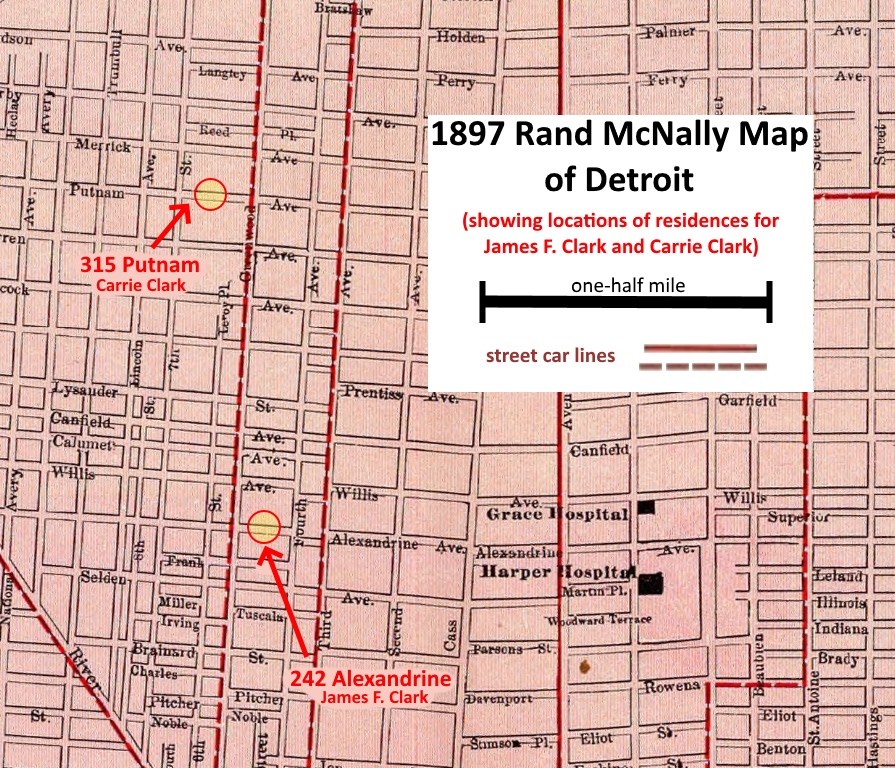 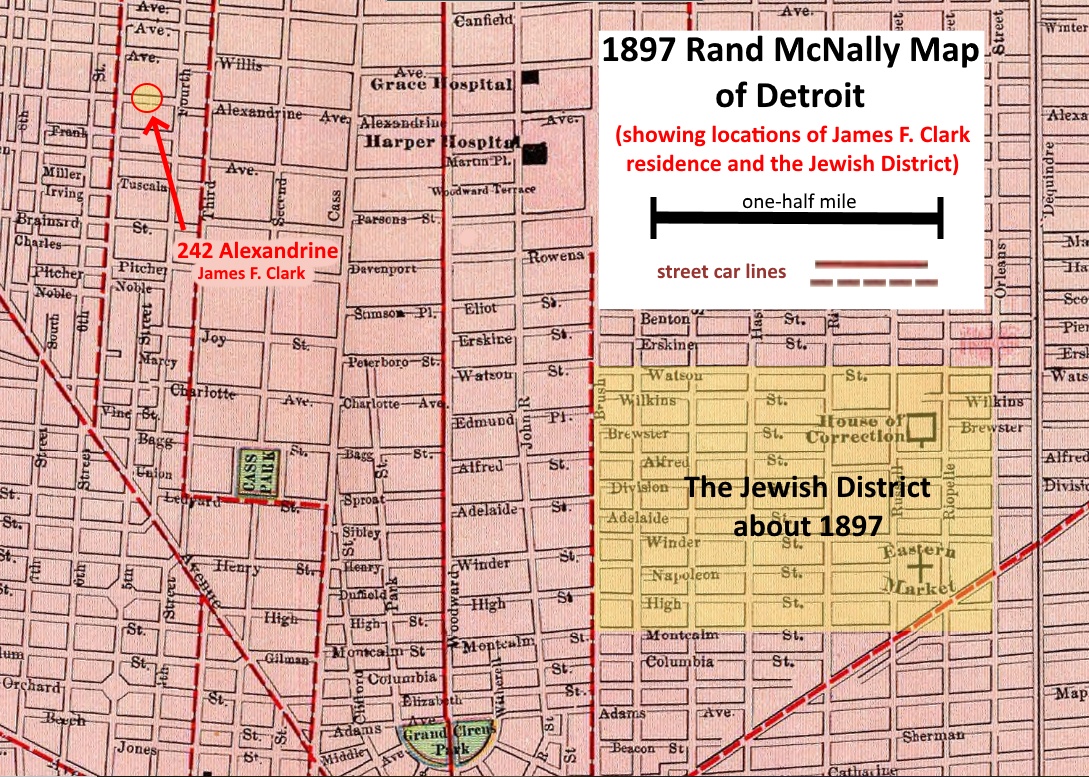
1897 Rand McNally maps of Detroit showing where Carrie Clark and James F. Clark lived.
The Clark Family of Edinburgh - Several years of genealogical research has revealed a family from Scotland, who may, or may not, be related to our grandfather James Frederick Clark, Sr. of Detroit. We will refer to them as the "Clark Family of Edinburgh", and many remarkable coincidences seem to exist between their lives, and the family stories that we have of our grandfather. The patriarch of this Edinburgh family is one Frederick Clark, who was born about 1828, or so, somewhere in England, according to census returns. Although the details of his birth are largely unknown, his first-born and third-born children were born respectively in Bristol, Gloucestershire, and in London. Thus, it is possible that he may have come from one of those areas. Otherwise, the rest of his children were born in Scotland. 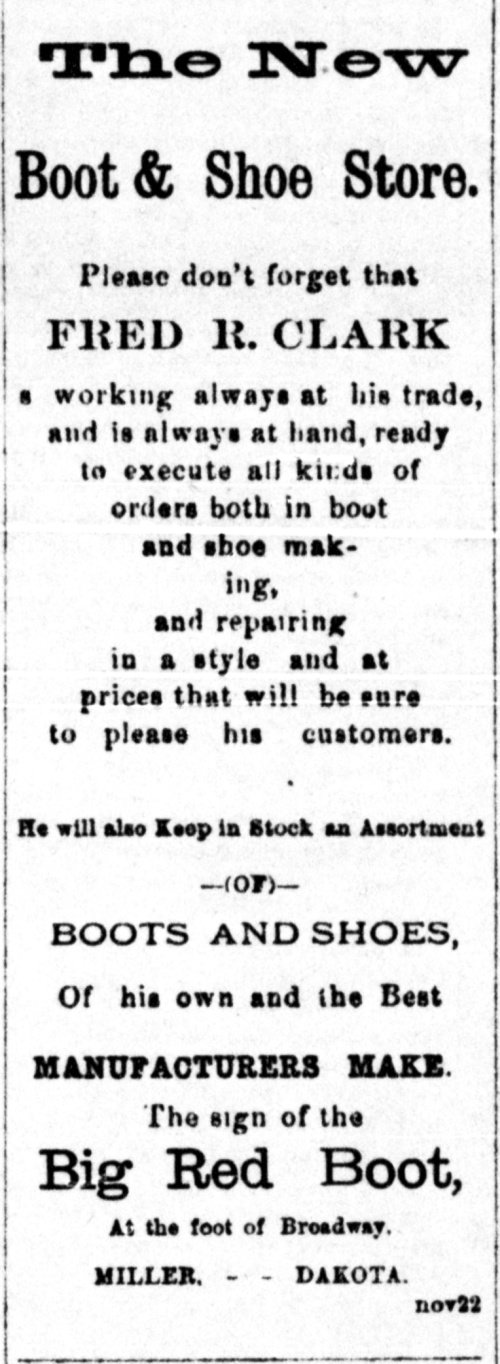
Frederick Clark's trade is shown in many documents as that of a boot- and shoe-maker. We know nothing of his training for this, but the fact that when he had a shop of his own, he always emphasized that he made and repaired both BOOTS and shoes, leads us to believe that during the early part of his career he was particulary involved in the manufacture and/or repair of boots. He never referred to himself as a "cordwainer", which is someone who made high-quality shoes, often from cordovan leather that made the shoes difficult and expensive to produce. Thus, most of Frederick's customers were probably the common folk, workers, and perhaps at times soldiers. The first actual mention we have of Frederick Clark is when he married his wife Mary Ann Brannan on Sep. 29, 1852 at the Tron Church on High Street in Edinburgh, Scotland. Census and other documents always show Ireland as Mary's birthplace, and her marriage record lists her as the daughter of Edward Branan, labourer. She may be the Mary Brennan, who was baptized on Jan. 17, 1830 as the daughter of an Edward Brennan in Castledermot, County Kildare, Ireland, which is near Dublin. However, we do not know this for sure. Because the groom and bride are shown on their marriage record to be from the same residence at 42 Blackfriars Wynd, they were already living together when they married. This record also gives the groom's occupation as shoemaker. The only other Edinburgh record of them from the 1850s is the 1856 baptism of their second daughter, their first being born in 1853 in England. We do not know and can only speculate as to when, how and why they came to Scotland. Frederick and Mary had a total of seven known children, six of whom survived. Their first and third children were born in England, the rest in Edinburgh. We are particulary interested in their oldest son, Frederick James Clark, who was born in 1863 in Edinburgh. He lived most, possibly, all of his childhood in Edinburgh, and the 1881 Scotland Census shows young Frederick, at age 18, employed as a "shopman" in his father's "bootmakers" shop. This would seem to imply that the young Frederick at the time was well on his way to learning his father's trade. 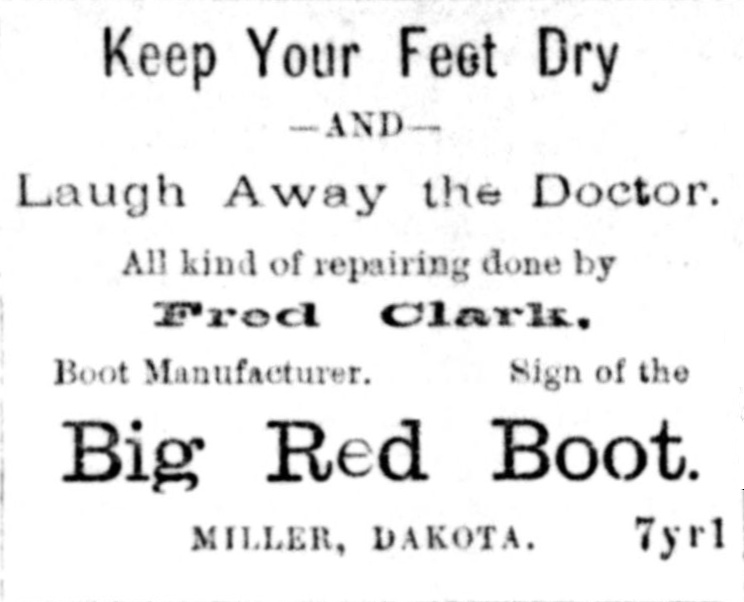
Then the entire family in 1881, just weeks after the census, emigrated to the United States. There Frederick, Sr. the following year acquired a federal patent for a 160-acre homestead near the town of Miller in Hand County, in that part of the Dakota Territory that eventually became South Dakota. He also set up a shop in town, where he made and repaired boots and shoes. His three sons subsequently moved to the "East", where they are said to have married, and his three daughters relocated to the area of Spokane, Washington, where they found husbands, and the two younger girls had children. The elder Frederick and Mary Ann by the late 1890s moved to the Spokane area as well, so that they could be near their daughters. Here Mary Ann died in 1897 in an asylum, and Fred died two years later in the nearby town of Rosalia. Both are buried in the general area, but in different cemeteries. There is little else to add about the eldest son Frederick James Clark. He settled initially with his family in Miller, South Dakota, and became a U.S. citizen there in 1883 at the county court house. Then he acquired a homestead in 1888 to the north of town. His younger brother Charles made a statement in 1893 to the Miller town newspaper that all of the children in the Clark family, which would include Frederick, were married by then; and Frederick is listed in the 1895 Iowa State Census as a visitor at Charles' home in Des Moines, so Frederick was still alive then. He is also mentioned in his father's 1899 obituary as living in "the east", but this may be newspaper reporter hearsay that is not entirely accurate.
Some Guesses - If the Clark Family of Edinburgh is indeed somehow related to our grandfather, James Frederick Clark, Sr., then we can make some guesses about his parents and grandparents. But before we fabricate a story, there are a few key assumptions that we want to make.
Our family stories regarding a British Soldier who went to Ireland and took an Irish-born wife might actually refer to the grandfather of Jim Clark, Sr, and not his father. This would of course diminish the amount of Irish DNA, if any, in the descendants of Jim Clark, Sr. Also, this Irish-born wife may very well have had English, not Irish, ancestry, especially if she was born in either Northern Ireland, or in the Dublin area. DNA evidence from multiple sources, and the Michigan WWI Veterans Census, seem to indicate that the biologic mother of Jim Clark, Sr. is a woman named Madge, who was a daughter of German-Polish shoemaker Johann Lewandowski (1814-1889). Furthermore, Carrie Finnegan, whom Jim identifies on his 1923 marriage certificate as his Irish mother, is more likely to be a stepmother, who raised Jim after his biologic mother Madge died. Jim is said to have also had a German stepmother, from about 1894 or 1895, when he is said to have become an orphan, up to maybe 1901 or 1902, when he is said to have run away from home. We do not know for certain the name of his German stepmother, but we very strongly suspect that she might be a sister-in-law of his biologic mother Madge. There also appear to be some remarkable coincidences between factual stories of the Clark Family of Edinburgh that that based on historical evidence, and the story of the family of our grandfather Jim Clark, Sr, as related to us by his only son. Frederick James Clark's birth name, birthdate and birthplace: Mandatory registration of births began in 1850 in Scotland, and a search of the Scotland birth index for a man named James F. Clark, born from 1850 to 1870 produces only one likely candidate for the father of James F. Clark, Sr. (1889-1942) -- Frederick James Clark, who was born in 1863 in Edinburgh. Immigration of the Clark Family of Edinburgh to the United States: They sailed on the S.S. Anchoria from Glasgow, arriving on May 11, 1881 at Ellis Island in New York Harbor, after a voyage of probably 10 to 12 days. They subsequently settled in South Dakota, after spending a short time at Heron Lake, Minnesota. The elder Frederick Clark's birthplace in England: This means that his ancestry was English, not Scottish, and his male descendants would have Y-DNA that is English in origin, not Scottish. The elder Frederick Clark's trade as a boot and shoemaker: Also, the fact that his son Frederick Jr. worked for his father as a shopman, and therefore would have known something of the boot and shoemaker's trade. The coincidence here is that Johann Lewandowski (1814-1889), the maternal grandfather of James F. Clark, Sr., was a shoemaker also. THE STORY WILL FOLLOW, WHEN IT IS WRITTEN . . .
Copyright © Michael S. Clark, Ph.D., 1998- - All rights reserved. |
 Detroit Origins of James F. Clark, Sr. (1889-1942)
Detroit Origins of James F. Clark, Sr. (1889-1942) 

